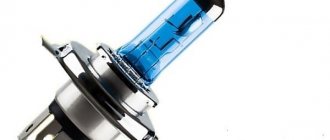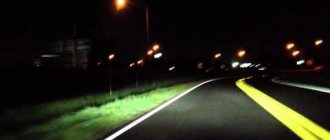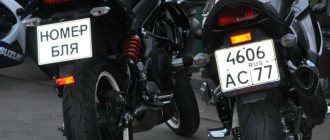What is xenon, why is it installed?
Xenon is the common name for gas-discharge lamps in which an electric arc glows in a bulb filled with gas - xenon.
This source produces bright white light, close to daylight. Xenon lamps do not have a filament like halogen lamps. An electric arc occurs between two electrodes. To ignite the arc, it is necessary to generate high-voltage (up to 25,000 V) voltage pulses. Therefore, to “ignite” such a lamp, a special control unit is used, which increases the voltage when the headlights with xenon lamps are turned on. After the lamp is lit, a nominal voltage of up to 80 V is sufficient to maintain the discharge.
Which headlights can xenon be installed in?
On February 20, 2010, the Road Safety Department of the Ministry of Internal Affairs of Russia gave an explanation “On the use of xenon headlights” (full text of the letter here).
Currently, the following officially approved types of headlights are installed on vehicles:
- C - low beam, R - high beam, CR - dual-mode (low and high beam) light with incandescent lamps (UNECE Rules No. 112, GOST R 41.112-2005);
— HC — low beam, HR — high beam, HCR — dual-mode light with halogen incandescent lamps (UNECE Rules N 112, GOST R 41.112-2005);
— DC — low beam, DR — high beam, DCR — dual-mode light with gas-discharge light sources (UNECE Rules N 98, GOST R 41.98-99).
An appropriate marking indicating the type of headlamp (exterior light fixture) and the approval mark (consisting of a circle containing the letter “E” followed by the number of the country which has granted approval and the approval number) is affixed to the lens of the headlamp and on the headlamp housing, if the lens can be separated from it.
The category designation for halogen incandescent lamps, shown on their base or bulb, begins with the letter “H”.
Gas-discharge light sources, the category marking of which, indicated on the base, begins with the letter “D”, in accordance with the requirements of UNECE Regulation No. 99 and GOST R 41.99-99 “Uniform provisions concerning the official approval of gas-discharge light sources for use in officially approved gas-discharge optical elements of motor vehicles" are intended for use only in headlights of DC, DR, DCR types.
Therefore, xenon lamps can only be installed in headlights marked DR, DC, DCR. If you have installed gas-discharge lamps in a headlight marked HR, NS, HCR, then you will not be able to persuade a traffic police officer to give a verbal warning if he notices a violation.
Why was the installation of xenon banned?
The above document provides explanations from the Federal State Unitary Enterprise “Research and Experimental Institute of Automotive Electronics and Electrical Equipment”, according to which the use of light sources in external lighting devices that do not correspond to the type of the given lighting device violates the conditions for ensuring road safety due to a number of physical factors (dimensions of the spark discharge, wavelength, scattering angle of reflected radiation) and technical (class of reflective surface of the reflector, presence on the vehicle of an automatic light beam corrector and headlight washer) factors.
Thus, the use of gas-discharge light sources in headlights intended for use with incandescent lamps, including halogen lamps, is not permissible.
Xenon 2021: will they be fined?
Not long ago, fog lights with gas-discharge xenon lamps appeared on many cars. Let's take a closer look at how legal this is, and is there any benefit to installing xenon in fog lights (ptf) yourself? It is legal to install xenon in the PTF if they are structurally designed for this; the car’s foglights have the appropriate markings - D, DC, DCR. The designation D indicates that the PTF allows the use of xenon lamps. If a car's fog lights are marked with the letter H, it means that only halogen bulbs can be used in these PTFs, and it is illegal to install xenon bulbs. Therefore, if the design of fog lights on a car does not provide for the installation of xenon bulbs, then the penalty for “independent” xenon in the PTF will be the same as for similar xenon in the main light headlights.
Sometimes it happens that at the time of purchasing a car it was not equipped with xenon headlights, but today the manufacturer produces a similar model with xenon. If the owner wants to install xenon lamps in such headlights in the hope of not getting a fine for xenon in 2021, then it is better to purchase new special headlights. They should already be equipped with an automatic light beam corrector and washer. This way, you won’t be able to get “distributed” by accident to a traffic police officer. But only a technical supervision inspector and exclusively at a stationary post can determine the presence of xenon bulbs in the headlights of a car.
26 Jun 2021 stopurist 664
Share this post
- Related Posts
- When do you stop working at the Labor Exchange in Togliatti?
- Check debts on tax identification number with bailiffs
- Sample loan agreement between individuals
- Key skills that can be written on a resume
Punishment for non-standard xenon until 2021
There is no direct ban in the administrative code on xenon lamps in conventional headlights. Until 2021, for driving a vehicle with such headlights, traffic police officers qualified under Part 3 of Article 12.5 of the Code of Administrative Offenses of the Russian Federation :
Driving a vehicle on the front of which are installed lighting devices with red lights or red reflective devices, as well as lighting devices, the color of the lights and the mode of operation of which do not comply with the requirements of the Basic Regulations for the admission of vehicles to operation and the duties of safety officials traffic, -
entails deprivation of the right to drive vehicles for a period of 6 months. up to 1 year with confiscation of the specified instruments and devices.
What requirements of the main provisions are discussed in the law?
The appendix to the Traffic Rules contains a list of malfunctions and conditions when operating the vehicle is prohibited. These include cases where the number, type, color, location and operating mode of external lighting devices do not meet the requirements of the vehicle design. And also: when the headlights use lenses and lamps that do not correspond to the type of the given lighting device.
Thus, traffic police officers, in order to bring the driver to administrative responsibility, removed the ignition unit with a xenon lamp installed in the headlight and recorded markings on the headlight, which indicate that only a halogen lamp can be installed in it.
Similar cases were considered by magistrates' courts. Most of the reviews ended in deprivation of the right to drive.
Traffic rules and GOSTs about xenon
Paragraph 19 of the traffic rules specifies in detail how and when the driver is required to use the car’s lights while driving. In conditions of poor visibility, in the dark and in tunnels, high or low beam headlights should be turned on, depending on the accompanying situation (we are talking about switching high beam to low beam when there is oncoming traffic or the presence of bright lighting on the streets). If stopping or parking in the dark or in poor visibility conditions, the driver must turn on the lights. If their light is not enough, then it is allowed to turn on the low beam and fog lights.
The “Basic provisions on the admission of vehicles to operation” states that the use of vehicles that do not meet the design requirements is prohibited. Such prohibiting conditions also include the use of such lamps in headlights that were not provided for by the manufacturer when designing the vehicle. GOST R 51709-2001 specifies what types of headlights should be installed on a specific category of vehicle, and also describes in detail and calculates what the luminous intensity should be, the angle of inclination of the light beam from the lamp, etc. If such conditions are not met, the driver may be held liable in accordance with the Code of Administrative Offenses of the Russian Federation. Motorists often call this regulation the “xenon law,” but in fact, liability threatens not only those drivers who have installed white xenon lamps on their car, but also any others (halogen, LEDs) that do not meet the requirements of the factory headlight design.
Standard xenon
Since the installation procedure for xenon headlights and all related parts is expensive, it is used only by luxury car manufacturers or only by special order. A xenon lamp is a gas-discharge flask filled with inert gases. For it to work, it is necessary to install an ignition unit, which is the power source (other types of headlight lamps use an incandescent filament). Under the influence of an electric discharge, the gas inside the xenon flask turns into plasma and, due to the gas discharge, a glow occurs.
The driver will not receive a fine for xenon in 2021 if such headlights were installed at the factory or were installed independently and issued according to the law. To do this, you need to contact an expert organization, which will issue a protocol confirming the possibility of altering the headlights on a particular car. You need to contact the traffic police with this protocol and write a statement there. Experts from the State Traffic Inspectorate, or rather the technical supervision at the State Traffic Safety Inspectorate, will study the examination conclusion and put a resolution on the application if they do not find any problems. With a package of documents, the car owner must contact a licensed service center, where they will carry out all the work on installing xenon. After the installation is completed, you must once again undergo an examination, receive a diagnostic card confirming the technical inspection, and again contact the traffic police to receive a mark that the alteration was carried out legally. You can carry out the installation yourself, but to do this you need to declare all the work performed in the application. The rest of the design scheme is the same.
Non-standard xenon
All alterations that were not completed according to the scheme described above will be illegal. And the inspectors (traffic police officers or other authorized persons) will have every reason to hold the driver accountable for the use of lighting devices that do not meet the design requirements of the vehicle. In the automotive industry, you can often hear the term “collective farm xenon” - we are talking about the installation of such illegal light. The main risk of installing xenon lamps on their own is that drivers do not bother to completely replace the remaining headlight parts - nozzles, reflectors, etc. On the roads while operating a car, such negligence can lead to dire consequences - accidents due to blinding from the light of incorrectly installed lamps.
Fine for xenon in 2021
In 2021, the Plenum of the Supreme Court of the Russian Federation issued a resolution (dated June 25, 2019 No. 20), which clarified the issues of applying administrative legislation in the event of detection of illegally installed xenon in car headlights. Namely:
The objective side of the offense provided for in Part 3 of Article 12.5 of the Code of Administrative Offenses of the Russian Federation can only occur in the event of a simultaneous discrepancy between the color of the lights and the operating mode of such devices with the requirements specified by the vehicle manufacturer in the operational documentation.
If only the color or operating mode of the light devices installed on the vehicle does not comply with the above requirements, driving such a vehicle may be qualified under Part 1 of Article 12.5 of the Code of Administrative Offenses of the Russian Federation.
Thus, the wording of the law has not changed as a result. Its interpretation has changed. Currently, installing xenon in headlights not designed for this type of lamp is considered a modification to the design of the vehicle.
If a traffic police officer detects such a violation, he will issue a fine under Part 1 of Article 12.5 of the Code of Administrative Offenses of the Russian Federation, for which a fine of 500 rubles is provided. However, that's not all. Along with the fine, the inspector will demand that the violation be eliminated and set a period of 10 days for this. If the violation is not eliminated, the registration of the vehicle will be terminated.
Ask a Question
Here you can refer to the topic of the article or request assistance in appealing the fine
Don't miss new useful publications
We will tell you about the intricacies of the legislation, help you understand it and tell you what to do in controversial situations.
Is it possible to install xenon in fog lights?
To understand whether installation of xenon in PTF is allowed under the law in 2018 and whether it is possible to install light sources, you need to understand several issues. We are talking about legal grounds, as well as technical requirements for the car.
Legal basis
All data regarding the right and legal installation are indicated in the Traffic Regulations of the Russian Federation. Information on the approved types of optical devices, as well as their markings, is given in the clarification of the Department of Traffic Safety of the Ministry of Internal Affairs dated 2010. Data on the non-compliance of lighting sources with a specific type of optics are indicated in the faults section of clause 3.4 of the traffic rules. According to official information, inappropriate lighting fixtures are a dangerous defect that the car owner is required to correct.
Article 12.5 of the Code of Administrative Offenses of the Russian Federation stipulates penalties regarding the installation of xenon lamps on cars. This document states that liability arises if red lights or reflectors are installed on the front of the vehicle. The latter cannot have a color shade or operating mode that does not comply with current legislation. The installation of such light sources is considered a violation and the devices are subject to confiscation after collection.
Technical requirements
According to current legislation, car owners have permission to install the following types of optical devices on their cars:
- Incandescent light bulbs. Headlights in which installation is possible are marked with the symbols C, R or CR. The first are low beam, the second are long-range, and the third are dual-mode light.
- Halogen type devices. Optical instruments are marked with the symbols NS, HR, and HCR. The installation principle is the same as in the previous case.
- Gas discharge devices or xenon. Optical equipment is labeled as DC, DR or DCR.
If the legislation approves the possibility of using a certain type of optics, then the headlights are marked with a mark with a circle. It contains the symbol E, and behind it you can see the number of the country in which the use of light bulbs is allowed. The marking must include the approval number. This data is indicated on the scattering device or the body of the optical device.
Xenon optical devices are equipped with a marking that begins with the symbol D, and if the light source is different from the flashlight, this is a violation.
Gas-discharge lighting sources installed in special lamps will illuminate the road efficiently and will not dazzle other motorists. Their use in headlights is legal. But if you install xenon instead of incandescent or halogen bulbs, this will cause inconvenience to other drivers. Moreover, the quality of visibility will not change, but only the color of the lighting flux will change.
The Garage TV channel in a video showed the quality of road lighting when installing xenon fog lights.











